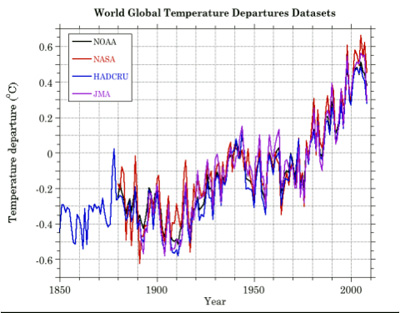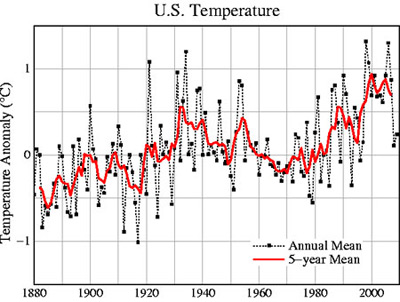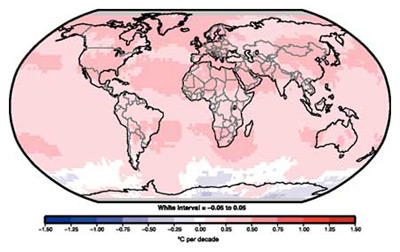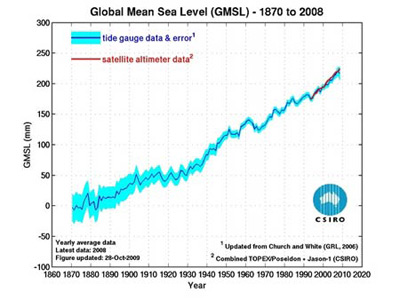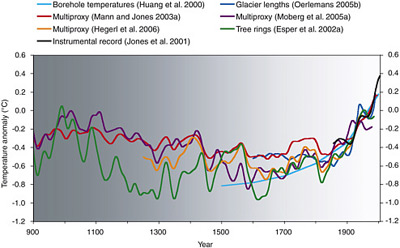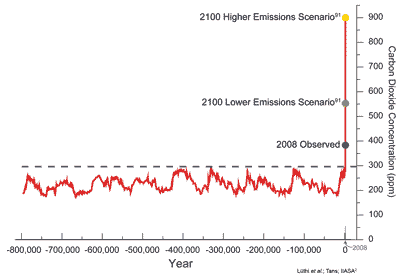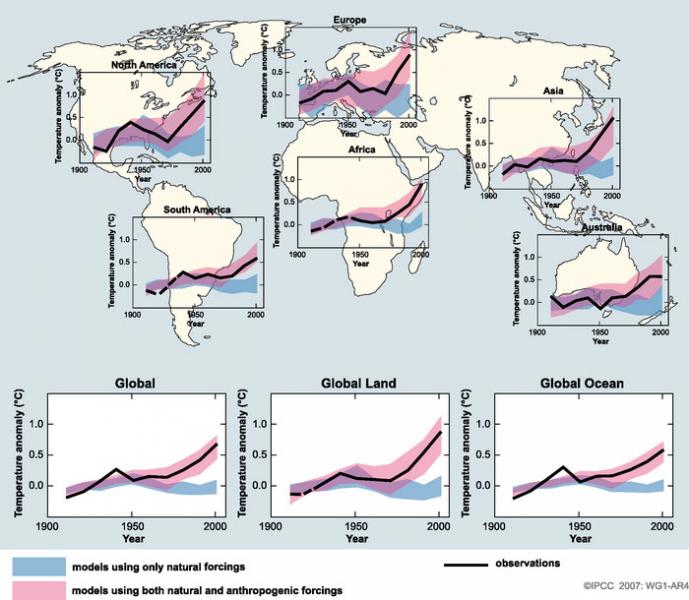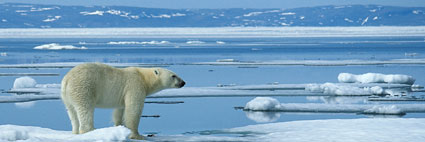We've already had 10 disasters topping $1 billion each and it's only September -- what gives?
September 12, 2011 |

Surveying damage from Irene in New Jersey.
Photo Credit: Agence France-Presse
LIKE THIS ARTICLE ?
Join our mailing list:
Sign up to stay up to date on the latest Environment headlines via email.
Floodwaters remain threatening in parts of the Northeast. A cresting Susquehanna River caused evacuations late last week in Pennsylvania -- the culprit that time was tropical storm Lee, which came on the heels of Hurricane Irene. These days extreme weather is beginning to seem like the new normal in a year marked by disastrous events -- deadly tornadoes, raging floods, crippling drought and wildfire, massive hurricanes, and don't forget the great white-out of "snowpocalpyse."
All these events have taken their toll on the country, both in terms of human lives lost and the amount of damages incurred. FEMA's disaster fund has dipped so low it is having to divert funds from Joplin, Missouri, site of the heartbreaking May tornado, to areas clobbered by Irene. The National Climatic Data Center (NCDC) reports that we've already set a record of 10 disasters over $1 billion each this year-- and it's only September.
So how bad have things been, and what's to blame? Let's take a look at the NCDC's list of wreckage of the last nine months.
1. Ground Hog Day Blizzard, Jan 29-Feb 3
It may be hard to think back to the frigid days of winter, but the massive storm that blanketed central and eastern states was a killer. It put Chicago under several feet of snow, claimed 36 lives and caused losses over $2 billion. The storm stymied travel, exhausted plowing budgets, and brought major cities to a standstill. For New York, the storm capped a month of snowfall that hit 36 inches.
2. Midwest/Southeast Tornadoes, April 4-5
Next came the beginning of a horrifying tornado season, which included five events topping $1 billion. The first, on April 4-5 hit 10 southern and central states with 46 tornadoes, losses over $2.3 billion and nine people killed.
3. Southeast/Midwest Tornadoes, April 8-11
Then came another 59 tornadoes that battered the Carolinas, Tennessee, Alabama, Texas, Oklahoma, Kansas, Iowa and Wisconsin. Total losses topped $2.2 billion but no casualties were reported.
4. Midwest/Southeast Tornadoes, April 14-16
This round of 160 tornadoes rocked Oklahoma, Texas, Arkansas, Missouri, Alabama, Georgia, the Carolinas, Virginia and Pennsylvania. North Carolina received the brunt with tornadoes killing 22 people out of the storms' total of 38 casualties. More than $2 billion in losses were reported.
5. Southeast/Ohio Valley/Midwest Tornadoes, April 25-30
And still the tornadoes kept coming -- this time 305 tornadoes and 327 people dead, 240 of them killed in Alabama. The twisters hit more populated areas like Tuscaloosa, Birmingham, Huntsville and Chattanooga, bringing the tab to over $9 billion.
6. Midwest/Southeast Tornadoes, May 22-27
Then came 180 tornadoes that terrorized central and southern states, claiming 177 lives and costing over $7 billion. The town of Joplin, Missouri lost 141 people and received the unfortunate honor of being the site of the country's deadliest tornado strike. Before and after photos of Joplin showed obliterated neighborhoods, roads, schools, churches and hospitals, and the media was filled with heartbreaking stories of people searching for loved ones.
7. Southern Plains/Southwest Drought, Heatwave and Wildfires, Spring-Summer
Texas, Oklahoma, New Mexico, Arizona, southern Kansas, western Arkansas and Louisiana have been massively hot and dry. This has resulted in mammoth wildfires, lost crops and livestock, charred homes, and dwindling water supplies. Texans have now experienced the hottest three months (June through August) ever recorded in the U.S. Climate-denying Texas governor Rick Perry has been praying for rain, but his prayers have done nothing to help the 3.6 million acres torched in his state. (It also hasn't helped that he cut the volunteer fire department budgets from $30 million to $7 million -- a really bad decision considering that most Texans' first line of defense is from the volunteer corps.) Across the Southwest and southern plains states, firefighting costs have reached $1 million a day. The total economic damages are still being tallied as this summer of hell is far from over, but losses to agriculture, cattle and buildings are more than $5 billion.
8. Mississippi River Flooding, Spring-Summer
The combination of massive rainfall and melting snow made for an epic flood event this year along the Mississippi and its tributaries, with losses creeping toward $4 billion and several lives lost. Homes and fields were submerged and towns evacuated. Photos showed water reaching the top of street signs, barns floating away and roadways disappearing into the floodwaters.
9. Upper Midwest Flooding, Summer
That wasn't the only big flood event of the year either. The same disastrous combo of snow melt and hefty precipitation set the Missouri and Souris rivers on a wild ride. Minot, North Dakota's 11,000 folks were sent packing as the water claimed 4,000 area homes. In all Montana, the Dakotas, Iowa, Kansas and Missouri lost homes, businesses and farms with damage estimates at over $2 billion and five deaths reported.
10. Hurricane Irene, August 20-29
And that brings us back to Irene's recent course through Eastern states. The final tab is still a guess, especially in a stunned and soggy Vermont. According to Circle of Blue, "Standard & Poor reported that total economic losses from the disaster could reach $US 20 billion, according to Reuters. Meanwhile, catastrophe modeler AIR Worldwide has insured-loss estimates between $US 3 to 6 billion, and risk-management firm Kinetic Analysis Corporation has estimated the total damage from Hurricane Irene at $US 7 billion." The death toll has now reached 45.
Why All the Weather Disasters?
After tallying the lives lost and property damaged, has all this weather taken a toll on our consciousness yet? Are people beginning to wonder if it's just a crappy, unlucky year -- or is there something else going on? Bill McKibben, the environmental author and activist, is hoping that people may begin to better understand how global warming can affect us by stepping back and seeing these disasters as part of a bigger picture. As McKibben told Amy Goodman this week on Democracy Now!:
We're in unprecedented, off-the-charts territory. It's not that there haven't been disasters before. There have always been disasters. Nature is relatively random in that sense. But now we're seeing two things. One, disasters that go beyond the bounds of what we've ever seen before. Because there's more water in the atmosphere, it's possible to have bigger floods, record snowfalls when it's cold, record rainstorms. And we're seeing more of them in conjunction. Think about what's been going on just on this continent this year. We're about one-and-a-half percent of the surface area of the globe in the continental U.S., and we've had not only this extraordinary flooding, but on the same day that Hurricane Irene was coming down, Houston set its all-time temperature record, 109 degrees. We're in the middle of the worst drought ever recorded in Texas. And, you know, Governor Perry's prayers for rain have so far been unanswered, maybe because he's done so little to ameliorate the flow of carbon into the atmosphere. We're in a new situation.
It doesn't mean that everything that happens is caused by global warming. Hurricanes aren't caused by global warming. They're caused by tropical waves drifting off the coast of Africa and encountering the earth's spin that can begin to set them into rotation. But they are made more powerful. As this hurricane rode up the coast, one of the reasons it was able to pick up so much water, that it's now dumping on Vermont and Quebec, is that sea surface temperatures were at an all-time record high off New York and New Jersey. Never--the last two years have seen the highest temperatures ever recorded in those waters. When you amp up a system--and so far we've added about three-quarters of a watt per square meter of the earth's surface extra solar energy to the planet by burning coal and gas and oil--when you do that, you can expect more dynamic, more amped-up, more violent weather. And that's exactly what we're seeing.
So, to recap -- it's not that any one of our weather events was caused by global warming; it's that global warming can make them worse. There is an increase in the frequency and the severity of storms -- wet storms get even wetter, heat waves get hotter and droughts get even drier. As Seth Borenstein writes for the AP, "This year, there's been a Pacific Ocean climate phenomenon that changes weather patterns worldwide known as La Nina, the flip side to El Nino. La Ninas normally trigger certain extremes such as flooding in Australia and drought in Texas. But global warming has taken those events and amplified them from bad to record levels, said climate scientist Jerry Meehl at the National Center for Atmospheric Research."
The National Oceanic and Atmospheric Associated reported that this year was the second hottest on record -- and last year was the hottest. They also turned up a few more disturbing facts:
- Only nine of the lower 48 states experienced August temperatures near average, and no state had August average temperatures below average.
- Wetter-than-normal conditions were widespread across the Northeastern United States, which had its second wettest August, as well as parts of the Northern Plains and California. Drier-than-normal conditions reigned across the interior West, the Midwest, and the South.
- Despite record rainfall in parts of the country, drought covered about one-third of the contiguous United States, according to the U.S. Drought Monitor. The Palmer Hydrologic Drought Index indicated that parts of Louisiana, New Mexico, Oklahoma and Texas are experiencing drought of greater intensity, but not yet duration, than those of the 1930s and 1950s.
- An analysis of Texas statewide tree-ring records dating back to 1550 indicates that the summer 2011 drought in Texas is matched by only one summer (1789), indicating that the summer 2011 drought appears to be unusual even in the context of the multi-century tree-ring record.
- Texas, Oklahoma, New Mexico, and Louisiana had their warmest (June-August) summers on record.
- The U.S. Climate Extremes Index, a measure of the percent area of the country experiencing extreme climate conditions, was nearly four times the average value was during summer 2011.
And if that's not enough, Arctic sea ice is at a record level low.
So, we've got extreme weather that is getting more dangerous. What are we going to do? Apparently not much. Writing for the Guardian, Jule Boykoff takes politicians -- especially the climate-denying Republicans -- to task for ignoring the perils of climate change. Boykoff writes:
As Republican candidates rehearse Exxon-esque talking points, journalists need to ask them where their weather and climate change thresholds lie. Someone should ask Perry, "At what specific threshold would you begin to 'believe' in global warming?" Would he reconsider his position if Texas were thrashed by an Old Testament-style concoction of droughts and tornadoes on an even more regular basis? How regular would this thrashing have to be? More than 97% of active climate scientists are in consensus that humans are contributing significantly to climate change. What percentage does he require to eliminate doubt? 99%? 109%?
Same goes for Obama. How many deaths and billions in economic damage from extreme weather would it take for him to take action to mitigate climate change and, for example, put the kibosh on the Keystone XL pipeline?
Here's the crux of this issue -- at what point are we willing to do everything we can to change the course we're on and demand the same from our elected officials? Perry and his Republican cohorts in the presidential race (minus Jon Huntsman) are adamant in their belief that climate change is not real despite the the conviction of 97 percent of people trained in that scientific field. Seems crazy right? Even crazier if you think about it this way: There's a 97 percent change our ship is going to sink. Wouldn't you want to get the heck off that boat?
There's no way off this planet, so why aren't we doing everything we can -- Republicans, Democrats, everyone -- to divert our ship from its disastrous course?
Tara Lohan is a senior editor at AlterNet and editor of the new book
Water Matters: Why We Need to Act Now to Save Our Most Critical Resource. You can follow her on Twitter @TaraLohan.

